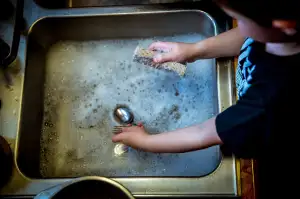Master the Art of Cleaning a Cast Iron Skillet: Essential Tips for a Spotless Kitchen

- Gather the necessary supplies for cleaning
- Preparing the skillet for cleaning
- Cleaning the skillet with hot water and a brush
- Removing stubborn food residue with salt or baking soda
- Drying the skillet thoroughly to prevent rust
- Applying a thin layer of oil to season the skillet
- Storing the skillet properly to maintain its condition
Cleaning a cast iron skillet is an essential task that every home cook should master. Cast iron skillets are prized for their ability to retain heat and distribute it evenly, making them perfect for searing meats and creating delicious, crispy dishes. However, without proper cleaning and maintenance, these versatile kitchen tools can become rusty, sticky, and lose their non-stick properties.
Regularly cleaning your cast iron skillet not only ensures its longevity but also enhances its cooking performance. By removing food residue and preventing rust buildup, you can continue to enjoy the benefits of cooking with a well-seasoned skillet. In this article, we will guide you through the necessary steps to clean and maintain your cast iron skillet, ensuring it remains in pristine condition for years to come. So let's dive into the world of cast iron skillet cleaning and elevate your food game today!
Gather the necessary supplies for cleaning
Gathering the necessary supplies for cleaning your cast iron skillet is essential to ensure a spotless kitchen. To effectively clean your skillet, you will need the following items:
1. Hot water: Hot water is crucial for loosening food particles and grease from the surface of the skillet.
2. Brush or sponge: A brush with stiff bristles or a sponge specifically designed for cast iron cookware will help scrub away any residue without damaging the seasoning.
3. Salt or baking soda: These natural abrasives can be used to tackle stubborn food particles that are stuck on the skillet.
4. Paper towels or cloth towels: These will be used to dry the skillet thoroughly after cleaning.
5. Cooking oil: A high smoke point oil like vegetable oil or flaxseed oil should be kept on hand to season the skillet after cleaning.
By having these supplies readily available, you'll be well-prepared to tackle any mess and maintain your cast iron skillet in top condition.
Preparing the skillet for cleaning
Before you begin cleaning your cast iron skillet, it's important to prepare it properly. Start by allowing the skillet to cool down completely after use. This will prevent any potential accidents or burns during the cleaning process.
Next, remove any excess food particles or debris from the skillet. You can do this by gently scraping the surface with a spatula or a stiff brush. Be careful not to use anything too abrasive that could damage the seasoning of the skillet.
Once you have removed the larger pieces of food, rinse the skillet under hot water. Avoid using soap at this stage as it can strip away the seasoning. Instead, focus on using hot water and a brush to scrub away any remaining residue.
If there are still stubborn bits of food stuck to the skillet, you can create a paste using salt or baking soda and water. Apply this paste to the affected areas and scrub gently with a brush or sponge until the residue is loosened.
After you have thoroughly cleaned the skillet, rinse it again under hot water to remove any remaining salt or baking soda. Make sure all traces of cleaning agents are gone before proceeding to dry the skillet.
By following these steps to prepare your cast iron skillet for cleaning, you'll ensure that it's ready for a thorough and effective cleaning process in order to maintain its longevity and performance in your kitchen.
Cleaning the skillet with hot water and a brush
To clean a cast iron skillet, start by rinsing it with hot water immediately after use. Avoid using soap, as it can strip away the skillet's seasoning. Instead, use a stiff brush or sponge to scrub away any food particles. The hot water will help loosen stubborn residue and make it easier to remove. Be sure to scrub all areas of the skillet, including the sides and bottom. This will ensure that all food debris is removed and prevent any buildup that could affect the skillet's performance. Once you have thoroughly cleaned the skillet, rinse it again with hot water to remove any remaining residue.
Removing stubborn food residue with salt or baking soda
Removing stubborn food residue with salt or baking soda is a crucial step in cleaning a cast iron skillet. These natural ingredients are highly effective at breaking down tough, stuck-on food particles without damaging the skillet's seasoning.
To begin, sprinkle a generous amount of salt or baking soda onto the surface of the skillet. Then, using a damp cloth or sponge, scrub the area gently in circular motions. The coarse texture of the salt or baking soda will act as an abrasive, helping to lift off any remaining food residue.
For particularly stubborn spots, you can create a paste by mixing water with either salt or baking soda. Apply this paste directly to the problem areas and let it sit for a few minutes before scrubbing again. This extra step will provide additional cleaning power.
After thoroughly scrubbing the skillet, rinse it with hot water to remove any remaining salt or baking soda residue. Be sure to use only water and avoid using soap, as it can strip away the skillet's seasoning.
By using salt or baking soda to remove stubborn food residue from your cast iron skillet, you'll ensure that it remains clean and ready for future cooking adventures.
Drying the skillet thoroughly to prevent rust
After cleaning your cast iron skillet, it is crucial to dry it thoroughly to prevent rust. Excess moisture left on the surface can lead to oxidation and the formation of rust spots. To ensure a spotless kitchen, follow these steps for proper drying:
- Use a clean towel or paper towels to remove any remaining water from the skillet's surface.
- Place the skillet on a stovetop burner set to low heat for a few minutes. This will help evaporate any residual moisture.
- Alternatively, you can place the skillet in an oven set to a low temperature (around 200°F or 93°C) for about 10-15 minutes.
- Once completely dry, turn off the heat and let the skillet cool down before proceeding.
Remember, thorough drying is essential for preventing rust formation on your cast iron skillet. By taking this extra step, you'll ensure that your skillet remains in top condition and ready for your next cooking adventure!
Applying a thin layer of oil to season the skillet
Applying a thin layer of oil to season the skillet is a crucial step in maintaining its quality and preventing rust. After cleaning and drying the skillet, it is important to coat it with a thin layer of oil. This helps create a protective barrier on the surface of the skillet, preventing moisture from coming into contact with the iron and causing rust. Additionally, seasoning the skillet with oil helps build up a non-stick surface over time, making it easier to cook with and clean in the future. To season the skillet, simply apply a small amount of vegetable oil or melted shortening to a paper towel and rub it all over the surface, including the handle and exterior. Make sure to remove any excess oil to avoid sticky residue. Seasoning should be done regularly to maintain the skillet's optimal condition and ensure its longevity.
Storing the skillet properly to maintain its condition
Storing the skillet properly is crucial for maintaining its condition and preventing rust. After cleaning and drying the skillet, make sure it is completely cool before storing. Avoid stacking other cookware on top of it, as this can cause scratches or damage to the seasoning. To protect against moisture, place a paper towel or clean cloth inside the skillet before storing. Store in a dry place with good air circulation to prevent any moisture buildup. By following these storage tips, you can ensure that your cast iron skillet remains in optimal condition for years to come.
In conclusion, regular cleaning and maintenance of your cast iron skillet is essential for several reasons. Firstly, it helps to preserve the skillet's non-stick surface, ensuring that your food cooks evenly and doesn't stick to the pan. Secondly, proper cleaning prevents the buildup of harmful bacteria that can contaminate your food. Additionally, maintaining a clean skillet prolongs its lifespan, saving you money in the long run. By following these simple steps and incorporating regular cleaning into your kitchen routine, you can ensure that your cast iron skillet remains in excellent condition for years to come.
Published: 20. 02. 2024
Category: Home



